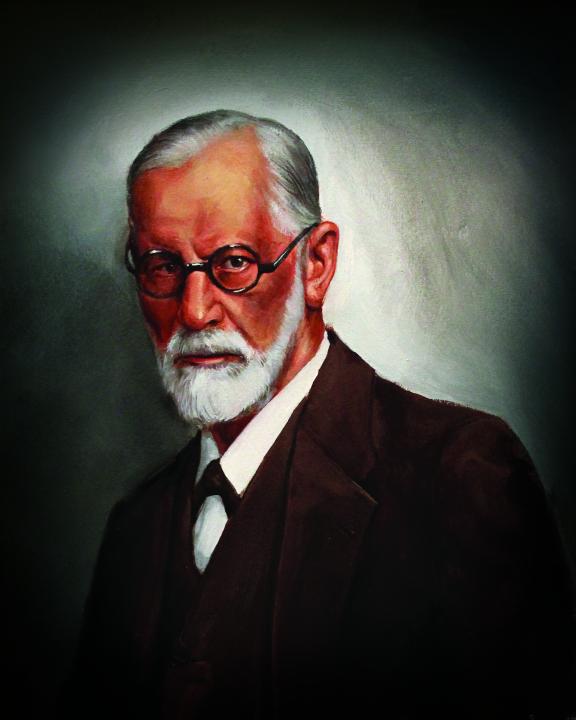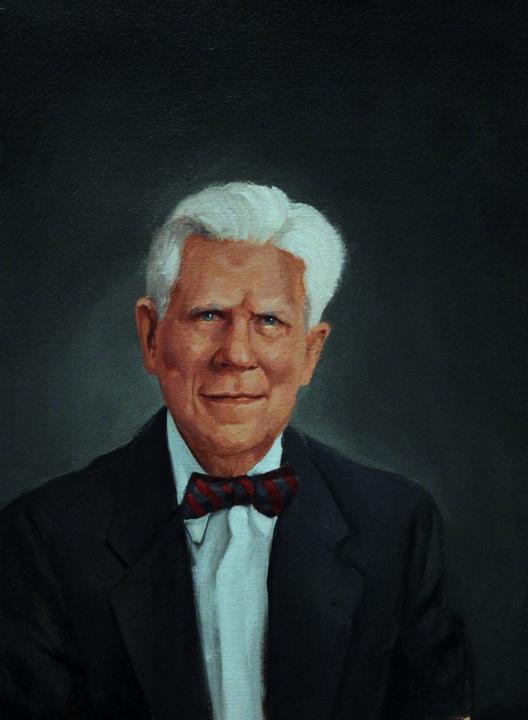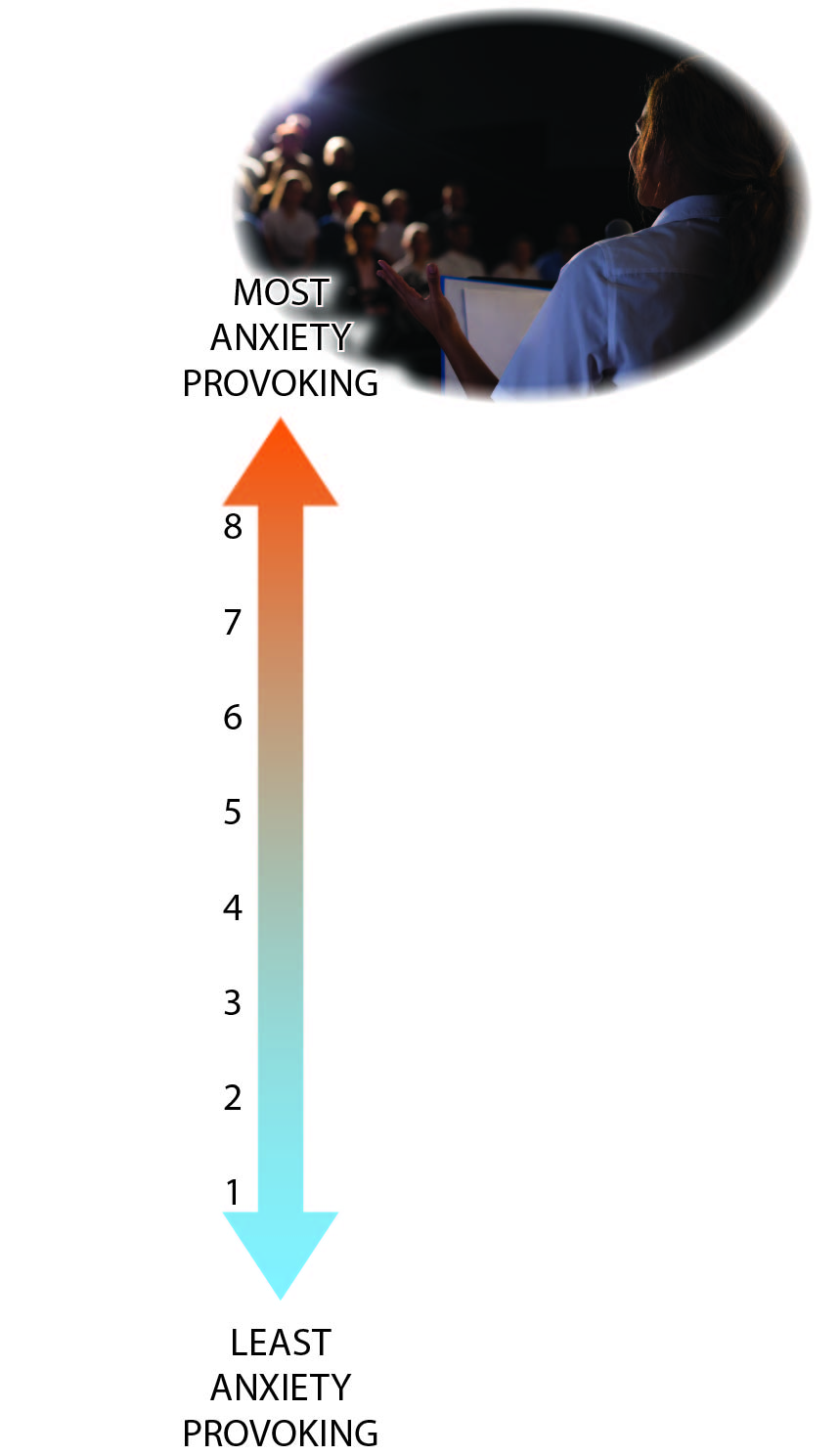Chapter 14. Treatment of Psychological Disorders “A Little Help from My Friends”
Introduction

Your professor announces that everyone will need to present on a specific topic in class in 3 weeks. The presentation will replace your research paper and will be worth 50% of your final grade. As she finishes the announcement, you begin to experience a panic attack: hyperventilating, sweating, and experiencing incredible chest pain. You think: “I’m going to be sick. I feel like I’m going to die!” You rush out of the classroom, thinking that you’re done with life as a college student. Thankfully, a friend from your class follows you out to make sure that you’re OK. She gets you some water and a wet towel and sits down on the stairs with you. You say, “I can’t do this presentation. I just can’t do it… or I’m going to die.”
14.1
Part of you realizes that you need to seek out therapy to help you overcome your overwhelming fear of public speaking. College is preparing you for life. You need to give this presentation to pass your class and to prepare you for other presentations in your future. You decide to face your fear and get some help.
Question
14.2
What kind of therapy should you seek? Let’s examine the different types of therapy and then narrow them down to a therapy that might work best for you. For each of the following definitions, use the drop-down menu to select the therapy that best fits the description.
Question
9JUDu5aVIbse10Hhdw57eeNe5Vtl7ztHpCssZVyYlzIJsWntl6ce1+qTI2Y/IdiBRTGtrEgWKn84U6QDfNRJ51FRSIbM1kL27f25UC9q7QRLGfaqsugkxfCrOTc+XXPX5cFYSW+NQp3yx2CPtMeRV6acO0uiKKE+tGGqJXns7GDaZHD67sm/Fo9oNpyPxWLTAiZUOX9vsxhba5TL
ZUG6uU9pe63rHS+3CBBj3wFWhP/McXTBmv8Apuduuu7WTNHEZqUfuvjAIsqSSaBmocHDq8o7z3XCvNJv1FX8pHA63tIC5AsofSRa6mEmzDWvgAYCEw/8IrntuPT0Defk35+mxOom3Tq2KHeMTOS0U1/eoP9qgdZ71pheBg==
ia7q9HUxnugDdNOyDL0aDSCTvZNC1E2xiMtEcKZn5PC96M7XNi2k6eSU5t9Ksx9FUo/2gVPUvQ01RPC7G4qh2qqb05Vh8g4rJ0PSHUuEsiQpqL2P6Jv6EKDn0UAiESfPpG/Ged0j1XU7hWaPujP2rI+6iuDx07Ot0LNp7Zjs0/a6YsDAwFrKeEzOI5qWoRR22I0wgWjsSk2GbbQL+Vi/aRzb8+0=
NUypE4DqAVYBXWW7aYsB6ntkGeUTdWs/Awx7ECJQhFqV8rz9Tx3O/P44CdO/zB0rMFT2r4vZ3/b6Je1OJPfAFpMsCyZzseqcVg7fXQNbPo9DzWVijJCRWD/Ctz8aJ8OWQO8XrnbUCMtr8OumsyzoUm0wWnK6G0Q7cTyYhPSqqK7p0JnMu68CfJyjVTHNaMkZKTAPqkc/bZcX6fI6iZVLI5ZZF/I=
rmZfbBlXyq36XC4B3ndZvZ6azt9jHLfhu7l6KqNu1KbvayptqEl7cN+u2AvuRghdFNnH/ansJXFfZsC63Fg/x1PugpMh0zRay6XAdCJfDLl/pbJiKYvnpQwzyqNEP9mZhQ+xZJO30bhadNumWBuCknIhEB36eR2Mzs8Oszf1eQuSs4UC5IU1V015rQn+GyHh
UERh7cv1ISDl5rM6AXxKFwkG2CX1JceZ7A3FkUQNVlDi6vLgzZJqNgNZATY3QRclKqnkmnbn6rCX/IYYMf5P7K2Za+ZJVxwUANC/Ux8m2U0g+0/x2qSZu4qw+QJNLaSu9KfdtORdcumsJ7NLlBC06yzvPBHFZOVR
zciUnXbJUnO0eZLUe6pH78itqmmXBdPCEIPTEjPg9zvYzrzPUaugvfTzjHcYniGOBIL2zqZTrLRKX3p/upQyKPfB5RhwnqdW5FuS6xsAWEPITEwLJcxLSshfj9+8PLTa+t5L+3loqYjSXTcAmp3tz7mIIZwHVapI
4gotc0pZN9s0mn/YsFSLdNwNzl824XetLP5FLgnotRpQPNl6dbrHkiZk8DJgzz50p+XZhqG+XsHK3+aSxVLF/7tg0VLVdNlgpCCW0Y0O9Qr6yVOr9FCHfg9U1toa2CFLW+Xsx6/lxFeQ6DGLK75iBJziAszpOgoiIlqoGLlDpdBPFT0x

14.3

Let’s figure out the best type of therapy for your social anxiety disorder. There are many different types of therapy, but not all of them are best for all disorders. For example, if you were showing signs of schizophrenia, biomedical interventions in the form of antipsychotic medication are most effective at treating symptoms, and psychodynamic therapy by itself would be ineffective. Finding the correct therapy to treat your symptoms is one of the most important and challenging parts of the process.

14.4

We’re going to focus on four main forms of psychological therapy. You will receive information about each type of therapy, and then you will figure out which one is best for your situation. The first therapy is psychoanalysis, or its more modern term, psychodynamic theory. It is based on the Freudian ideas of consciousness, preconscious, and the unconscious. This therapy depends on dream interpretation, free association, resistance, and transference to deal with the effects of our repressed drives of sex and aggression. Psychoanalytic therapy is the oldest form of therapy, but there are criticisms. For example, psychoanalysis deals with unconscious thoughts, feelings, instincts, and desires of which we are largely unaware. This makes it difficult to objectively and scientifically evaluate and interpret these unconscious aspects. Studies have shown psychoanalysis to be effective for some psychological disorders, but a therapeutic relationship involving a lot of verbal expression and insight into one’s self is required .
Leichsenring, F., Abbass, A., Gottdiener, W., Hilsenroth, M., Keefe, J. R., Luyten, P., & Steinert, C. (2016). Psychodynamic therapy: A well-defined concept with increasing evidence. Evidence Based Mental Health, 19. doi: 10.1136/eb-2016-102372
Question
14.5
Another form of therapy that might be helpful to you is behavioral therapy. This type of therapy is based on the principles of classical conditioning and operant conditioning. Behavior therapies involve relaxation training, exposure to the anxiety-promoting situation, and replacing the feared outcome with a more positive outcome. Behavioral therapies usually involve relaxation training because you cannot feel anxious and relaxed at the same time. For example, the complete feeling of panic you were experiencing while thinking of doing your presentation does not fit with the feeling of relaxation.
Negative reinforcement also comes into play in behavior therapies. For example, if you avoid speaking to other people, you never have to be afraid of humiliating yourself. The exposure to speaking publicly can be broken down into small increments (systematic desensitization), or it can be delivered all at once (flooding). Behavior therapies have been shown to be helpful in treating many different anxiety disorders and, in many situations, are quicker than many other therapies. However, behavior therapies are based on learned behaviors, so they can’t always change a person’s thinking (“I’m going to die if I have to speak in front of other people.”). Also, unfortunately, spontaneous recovery can cause the old behaviors to come back.
Question
14.6

Another form of evidence-based therapy is cognitive therapy. Cognitive therapy is based on identifying the client’s (negative) misinterpretations of the world and helping the client to change those misperceptions. For example, the thought “When I get up to speak, everyone is going to make fun of me” may cause you to create a scenario in your head where you can’t possibly speak in front of the class. You may show patterns of automatic thoughts such as: “I just stuttered and everyone is looking at me. I’m an absolute idiot.” You may also exhibit cognitive distortions such as: “I’m going to fail this class because I can’t give the presentation. I might as well just drop out of school.” Cognitive therapy’s goal is to help clients recognize how their thoughts are affecting their beliefs and behaviors and help them change those negative automatic thoughts and cognitive distortions. Thousands of studies have demonstrated that cognitive therapies provide relief from symptoms of major depressive disorder, panic disorder, generalized anxiety disorder, social anxiety disorder, obsessive-compulsive disorder, and eating disorders .
Dugas, M. J., Brillon, P., Savard, P., Turcotte, J., Gaudet, A., Ladouceur, R., & Gervais, N. J. (2010). A randomized clinical trial of cognitive-behavioral therapy and applied relaxation for adults with generalized anxiety disorder. Behavioral Therapies, 41, 46–58.
Question
14.7
Question
4NCRH0kx9Vj07BYBKgi+MvPT5a7eZkCbjcZ+Xg==Humanistic therapy emphasizes the positive nature of humankind and helps clients reach their full potential and create a life beyond negativity and feelings of emptiness. In order to do this, humanistic therapists believe that a therapeutic alliance must be built between the client and the therapist. Humanistic therapy has proven useful with a variety of psychological disorders and stressful situations. Unfortunately, the methods of humanistic therapy are not “operationalized” so this approach is difficult to study.
Match the terms with the correct description to ensure that a therapeutic alliance can be built between the client and the humanistic therapist. Create matches by selecting the circle next to an option in the left column. Then click on the circle next to the option in the right column where you want to make the match.
Building a Therapeutic Alliance
14.8
Now you need to figure out which type of therapy will work best for you in the shortest period of time (that presentation date is coming up soon!). As you recall from your textbook, problem solving involves working through a variety of approaches to achieve a goal, in this case, giving your presentation to your class. Each type of therapy has demonstrated some effectiveness and helped clients with specific disorders. Which therapy is best for your situation? Let’s go through the steps of problem solving. The first step is understanding the problem.
Question
14.9
Now you know that your primary problem involves a specific fear, public speaking. The second step in problem solving is choosing an approach. You have learned about four different types of therapy.
Question
Question
qRP/fEq9JNQqk/98255amwHKVny9qf8WQ/Xk3FaXpo+ek2eJLakO+ihKLPD8rPUuDkJZUAEYY5ZIhzHSI3nnJ1JGXnnyow//Otaq7LZ6Wdq84DJWRFW2P+0J9KMQRg3zmpFHwYvQNsaurdcLqf/XKKlhr+d6hgdlqu/Gxp7iJ6/pBWKxpZeIkgaxy6VQbMpvC0UwjoCnfsccyZbMlvFUtF9qzxvT4bghhpIiVdfpThvk5Nm//GYVJY6W3m36dHwRmoImZwtJAzAkWUq3VZ/VnZyUL6ZJWjqHK6oiZVku6NMlsXqjjaAB7J2DLFsvPWm7QuGKH1X2sVRLOF1QW9TIQDeJkbTszcLR6DFMleQ8hCRsv4GAST6Ngy8dz15tDAmBfg5ytJ6itwRXBOPeDt1lz45Afz2kxu36NqC/2lNp4OlzXZKcqbfg7w==14.10
Question
uE3VhLMERo+pZCl6vBYetZDFr3Mvlay14MiAnA==You choose behavioral therapy because it best meets your needs. You make an appointment with a therapist who teaches you relaxation techniques such as deep breathing, visualization, and muscle relaxation. You also go through the process of systematic desensitization.
Create your anxiety hierarchy by ranking your fear about public speaking from the least anxiety-provoking situation to the most. Move items by dragging them to the correct location or by selecting an item and then selecting the location where it should move.

14.11
Question
ZtlghDi3xiBDDI4OeoWhYTteRpOc0K231GbjdxqLRV6kPOFSnyq/uUWlDRvVlB1+/sTtY2NH+V5srUWE60+F93AssH5FS+FpG1dZ7L8T8SCtpX08clRj2AoH7euCt2HHKctFF/58YHJP7Pky2zu0c/ojpL9l/1qNunAhhfxWely6+Gn6gP8ZCdlVZcfBbLb9IVMH1Gv2jkD2MXAKmp1yH6JPTzlMHQgjfZv3pryLcDxOJxra0BuHbEb2zIfDAcgJbgyknbQH17OgIixu2WvuPnIf8jPDg8wO14.12
As you have now seen with the example of systematic desensitization, gradual exposure to the feared stimulus along with relaxation training can help individuals to overcome their phobias. We are now going to watch a video of Mike, who had an extreme fear of going to a dentist. Pay close attention to how psychological techniques helped Mike overcome his fears and get the dental treatment that he needed.
MIKE: 12 months ago I needed to go and see a dentist, because I had tooth ache-- severe tooth ache. And I finally plucked up the courage to go and visit the dental surgery. I stood outside, could feel my heart pumping in my chest. A little bit like a panic attack, I suppose.
MAN: Right.
MIKE: Just couldn't walk over the threshold.
MAN: Mike has a dental phobia. To overcome his phobia, we're going to rewire his brain using a process called gradual exposure. It's a specialized treatment, and Tim Newton at Guy's Hospital in London is one of the world's leading experts.
TIM NEWTON: So what happens when you think about going to the dentist? What's going through your mind.
MIKE: Teeth being extracted, blood, pain.
TIM NEWTON: And instantly thinking it's going to be very, very unpleasant?
MIKE: Yeah.
TIM NEWTON: And so, one of the things, which we'll want to do, is sort of test the reality of that. And look to see whether that is what will really happen, so that we can change the way you think about the dentist situation. We're going to start today a sort of new approach, which we're developing here, which is using video. The idea is that we show you this and we ask you to practice relaxing yourself, calming yourself. Keep doing that until you can watch that bit of video without being too anxious. And then we'll start doing it in real life, and gradually, gradually build up until we've reached your goal, which is to be able to walk into surgery, sit in the chair, and have some treatment.
MAN: Under Professor Newton's instructions, Mike's been working hard on a number of techniques. As well as watching videos, he's written about his fears, he's listened to the sound of dental drills, handled dentist instruments, and developed a series of flashcards to highlight his key fears and ways to cope with them.
MIKE: To begin with, I must confess, I couldn't really see the point in some of this. But bit by bit, the building blocks have come together, and it's a bit like a snowball rolling downhill. The new experiences, and the desensitization, and the logic behind some of the way I feel and how I feel it has come together, it's actually been very, very good. And a lot of the historic experiences that were very poor have now been replaced by new ones, and the demons don't seem to be there.
Question
14.13
Question
Question
RwnP4o3eftr6GjeyBLoP6GGQxGfWKD+pMvUuSJ2RDTaF8CkT1NXPaE5Qsl0wUHhnOo/HFPaKp3RDJhkmWDlEMLpiGpq5+hSK3W/0MbsqRadyFdFUYM1xW9Mi5WpK6OTiO/+Q4yJuI8QSfEhY9PTufq8hvKsX/k7XuFOYoFT0AOptDQz74WlWJQohGSdjm/lvs6LMYE4A6pnN68F5qW29NbUfcUAR3Zzqn0BUpkVrjE0z+hOmcp+kSpuFmSiF1Kmcdj3Cnp7YRNYV55J0f2OUQk8HpB4i3kZweV3tCZRlTQPgzP7f0VVs2BCc0tTVmDJfqUiBGzfag90Lx8w5Gtty89KO+HQ/1ILKZY21MVJ8w6nr0QU+3R2uJ3w1e2RxsUF5RSsm80OxsKo+QOn2NUCuoexFP+QHS8EMmTi4nEO1S2w=14.14
Mental illness is real, but there are many therapeutic approaches to help people. Other options go beyond what has been discussed here. Some people benefit from biomedical interventions such as antidepressants. Some individuals learn to cope in a group setting. Most important is to get help if you need it; seeking out the best fit is key to success. The problem-solving strategies discussed in this activity should help you find the resources you need.